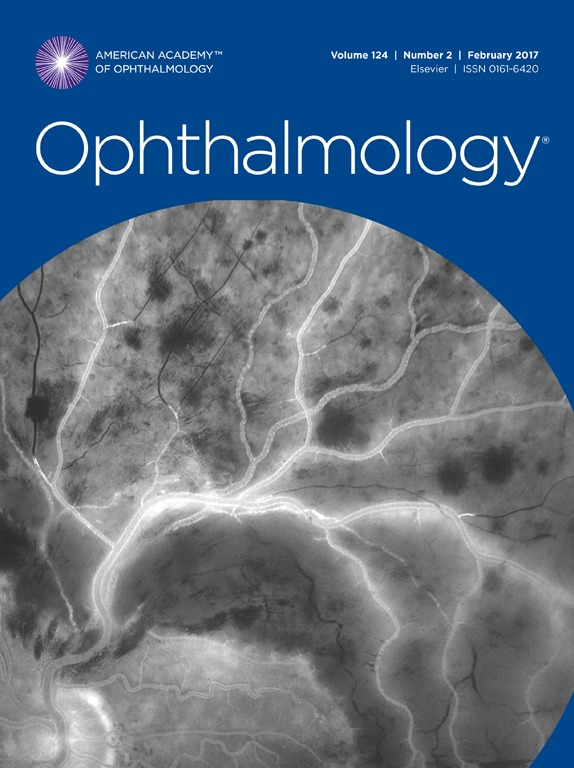GLP-1 受体激动剂和二甲双胍对 2 型糖尿病患者青光眼风险影响的比较。
IF 13.1
1区 医学
Q1 OPHTHALMOLOGY
引用次数: 0
摘要
目的:比较胰高血糖素样肽-1(GLP-1)受体激动剂和二甲双胍对2型糖尿病患者原发性开角型青光眼(POAG)、眼压过高和青光眼一线治疗需求的影响:设计:利用国际电子病历网络的电子病历(EMR)数据开展了一项回顾性队列研究,研究时间跨度为 2006 年 5 月至 2024 年 5 月:被诊断为 2 型糖尿病(T2DM)并接受 GLP-1 受体激动剂或二甲双胍治疗的患者:分析了来自 17 个国家 120 家医疗机构的数据。方法:分析了来自 17 个国家 120 家医疗机构的数据,评估了患者 1 年、2 年和 3 年的疗效。采用倾向评分匹配法(PSM)平衡人口统计学、合并症和用药情况等协变量。计算风险比(RR)及 95% 置信区间(CI):POAG、眼压升高的发生率以及一线治疗的需求,包括β-受体阻滞剂、前列腺素类似物、溴莫尼定、布林佐胺、多佐胺、奈达唑地尔和激光小梁成形术:经过 PSM 治疗后,两组患者中分别有 61 998 人接受了为期 1 年的随访,27 414 人接受了为期 2 年的随访,14 100 人接受了为期 3 年的随访。与服用二甲双胍的患者相比,接受 GLP-1 受体激动剂治疗的患者在 1 年(RR 0.59,95% CI 0.39-0.88)、2 年(RR 0.50,95% CI 0.32-0.78)和 3 年(RR 0.59,95% CI 0.37-0.94)时罹患 POAG 的风险显著降低。在眼压方面也观察到了类似的保护作用,1 年时风险降低 56%(RR 0.44,95% CI 0.31-0.62),2 年时降低 57%(RR 0.43,95% CI 0.30-0.62),3 年时降低 49%(RR 0.51,95% CI 0.34-0.75)。GLP-1受体激动剂组在1年(RR 0.63,95% CI 0.53-0.74)、2年(RR 0.71,95% CI 0.59-0.85)和3年(RR 0.75,95% CI 0.62-0.91)时开始一线治疗的风险也较低:结论:与二甲双胍相比,GLP-1 受体激动剂可显著降低 2 型糖尿病患者的 POAG、眼压升高和青光眼一线治疗需求。这些发现凸显了 GLP-1 受体激动剂对眼部的潜在益处,以及它们在糖尿病患者临床治疗中不断扩大的作用。本文章由计算机程序翻译,如有差异,请以英文原文为准。
Comparative Effects of Glucagon-like Peptide 1 Receptor Agonists and Metformin on Glaucoma Risk in Patients with Type 2 Diabetes
Purpose
To compare effects of glucagon-like peptide 1 (GLP-1) receptor agonists and metformin on the risk of primary open-angle glaucoma (POAG), ocular hypertension, and the need for first-line glaucoma treatments in patients with type 2 diabetes mellitus (T2DM).
Design
A retrospective cohort study was conducted using electronic medical records data from an international electronic health record network, covering a period from May 2006-2024.
Participants
Patients with a diagnosis of T2DM who were treated with either GLP-1 receptor agonists or metformin.
Methods
Data from 120 health care organizations across 17 countries were analyzed. Patient outcomes were assessed at 1, 2, and 3 years. Propensity score matching (PSM) was used to balance covariates such as demographics, comorbidities, and medication use. Risk ratios (RRs) with 95% confidence intervals (CIs) were calculated.
Main Outcome Measures
Incidence of POAG, ocular hypertension, and the need for first-line treatments including topical drops and laser trabeculoplasty.
Results
After PSM, both groups included 61 998 patients at the 1-year follow-up, 27 414 patients at the 2-year follow-up, and 14 100 patients at the 3-year follow-up. Patients treated with GLP-1 receptor agonists showed a significantly decreased risk of POAG development compared with those receiving metformin at 1 year (RR, 0.59; 95% CI, 0.39–0.88), 2 years (RR, 0.50; 95% CI, 0.32–0.78), and 3 years (RR, 0.59; 95% CI, 0.37–0.94). Similar protective effects were observed for ocular hypertension at 1 year (RR, 0.44; 95% CI, 0.31–0.62), 2 years (RR, 0.43; 95% CI, 0.30–0.62), and 3 years (RR, 0.51; 95% CI, 0.34–0.75). The risk of first-line therapy initiation also was lower in the GLP-1 receptor agonists group at 1 year (RR, 0.63; 95% CI, 0.53–0.74), 2 years (RR, 0.71; 95% CI, 0.59–0.85), and 3 years (RR, 0.75; 95% CI, 0.62–0.91).
Conclusions
Glucagon-like peptide 1 receptor agonists are associated with a significantly lower incidence of POAG, ocular hypertension, and the need for first-line glaucoma treatments compared with metformin in patients with T2DM. These findings highlight the potential ocular benefits of GLP-1 receptor agonists and their expanding role in the clinical management of patients with diabetes.
Financial Disclosure(s)
Proprietary or commercial disclosure may be found in the Footnotes and Disclosures at the end of this article.
求助全文
通过发布文献求助,成功后即可免费获取论文全文。
去求助
来源期刊

Ophthalmology
医学-眼科学
CiteScore
22.30
自引率
3.60%
发文量
412
审稿时长
18 days
期刊介绍:
The journal Ophthalmology, from the American Academy of Ophthalmology, contributes to society by publishing research in clinical and basic science related to vision.It upholds excellence through unbiased peer-review, fostering innovation, promoting discovery, and encouraging lifelong learning.
 求助内容:
求助内容: 应助结果提醒方式:
应助结果提醒方式:


